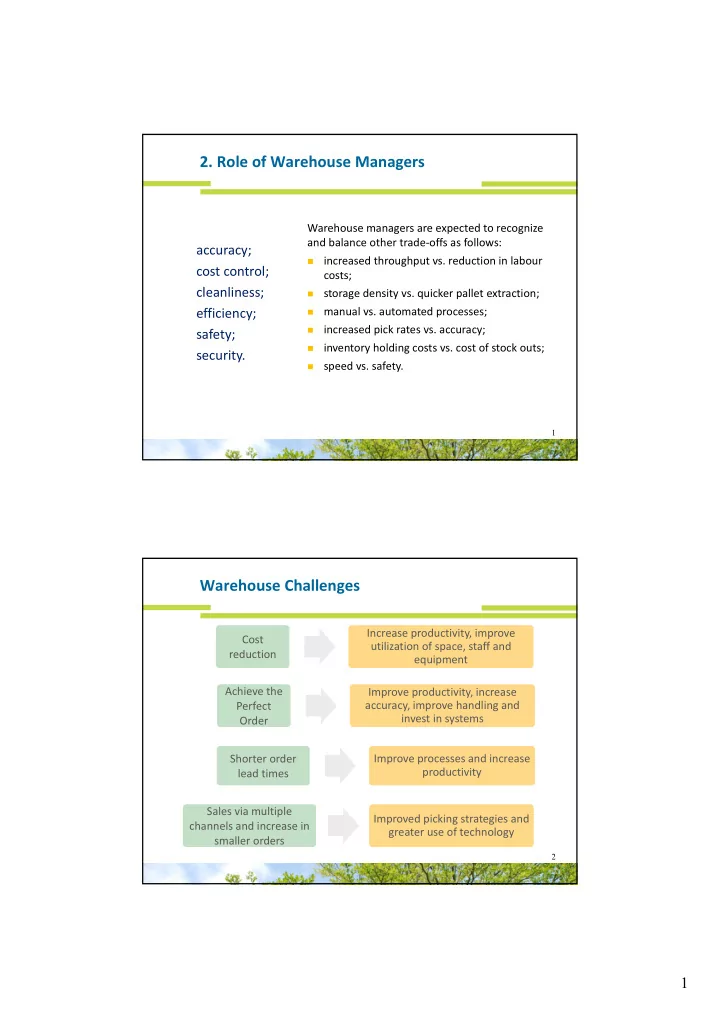

2. Role of Warehouse Managers Warehouse managers are expected to recognize and balance other trade ‐ offs as follows: accuracy; increased throughput vs. reduction in labour cost control; costs; cleanliness; storage density vs. quicker pallet extraction; efficiency; manual vs. automated processes; increased pick rates vs. accuracy; safety; inventory holding costs vs. cost of stock outs; security. speed vs. safety. 1 Warehouse Challenges Increase productivity, improve Increase productivity, improve Cost Cost utilization of space, staff and utilization of space, staff and reduction reduction equipment equipment Achieve the Achieve the Improve productivity, increase Improve productivity, increase accuracy, improve handling and accuracy, improve handling and Perfect Perfect invest in systems invest in systems Order Order Shorter order Shorter order Improve processes and increase Improve processes and increase productivity productivity lead times lead times Sales via multiple Sales via multiple Improved picking strategies and Improved picking strategies and channels and increase in channels and increase in greater use of technology greater use of technology smaller orders smaller orders 2 1
Warehouse Challenges Fluctuations Fluctuations Flexible working hours and Flexible working hours and improved forecasting improved forecasting in demand in demand Proliferation Proliferation Improved use of equipment such as Improved use of equipment such as carousels, A ‐ frames and flow racks carousels, A ‐ frames and flow racks of SKU of SKU Staff retention through excellent Staff retention through excellent Labour cost and Labour cost and working conditions, flexible hours, working conditions, flexible hours, availability availability training and improved productivity training and improved productivity Increasing cost of energy and Increasing cost of energy and Manage energy more Manage energy more efficiently, better use of waste efficiently, better use of waste environmental challenges environmental challenges Data accuracy and Data accuracy and Introduce WMS and real ‐ Introduce WMS and real ‐ speed of transfer speed of transfer time data transfer time data transfer 3 Lean Warehousing Seven Wastes or Muda transportation (driving an empty forklift) 空車行駛 defects (time spent correcting errors such as misspicks) 揀錯 inventories (congestion at the inbound and outbound areas) 進出貨區域擁擠 motion (interrupting movement such as staging product before put ‐ away) 入庫作業中斷 waiting time (bottlenecks at pick locations) 等候揀貨 overproduction (holding too much inventory) 庫存過多 overprocessing (performing unnecessary steps such as labelling and checking) 非必要的檢查 4 2
Examples half ‐ height and quarter ‐ height pallets taking up space in two ‐ metre ‐ high locations; Solution: moving smaller pallets to other locations, reducing beam heights or adjustable heights part pallets of the same product spread over a number of different locations; Solution: Consolidate the pallets. Tradeoff between labour cost and storage space. over 10 per cent of the stock was obsolete. Solution: Decisions have to be made in conjunction with the finance department to dispose of obsolete product 5 5S Sort or Seiri or Clear out Straighten or Seiton or Configure Shine or Seiso or Clean Standardize or Seiketsu or Conform Sustain or Shitsuke or Custom 6 3
Workforce Management identifying, attracting and retaining good supervisors, first line managers and team leaders; 基層幹部 retaining and attracting new employees; 員工流動率 an ageing and constantly changing workforce, including the introduction of foreign staff; 外勞 identifying training needs; 訓練 the need to provide safe, comfortable working conditions; 安全 employment contract negotiations; 彈性工時 compliance with employment and health and safety legislation 勞基法 staff discipline. 7 Attracting and Retaining Employees Many firms see monetary incentives as being key to staff recruitment and retention Surveys suggests otherwise with active employee involvement in productivity improvement, … being seen as high on the list. (52) Flexible hours, recognition of a job well done, clean and safe working conditions, … crucial to attracting and retaining staff. (52) As warehouses become more technically advanced this will also attract a new breed of warehouse employee – those with an interest in technology and automation. 8 4
Problem ‐ solving Skills The majority of managers suggested the following areas were most inefficient: –– inventory control (53 %); –– picking (47 %); –– putaway and replenishment (45 %). Managers will not review their workflow processes until they receive a customer complaint According to Goldratt (1984) every operation has some kind of constraint that stops it from operating optimally … identify the constraint and change the way you work to overcome it. (49) 9 Theory of Constraints Congestion at a pick face can be an example of a bottleneck: 揀貨作業過於擁擠而造成瓶頸 identified by people waiting in turn to pick items; try to maximize productivity under the current situation; don’t overload the system by sending too many pickers to the same location; increase the number of pick locations for that product. 10 5
Warehouse Audit ISO 9001 – a standard of requirements against which your Quality Management System can be evaluated; 產品品質 ISO 14001 – a standard of requirements that defines and establishes controls to reduce your company’s impact on the environment; 環保 ISO 50001 – a standard of requirements that deals with the energy impact of your warehouse operation; 節能 OHSAS 18001 – a standard of requirements against which your Health and Safety Management System can be evaluated; 職業健康安全 EICC Electronic Industry Citizenship Coalition 電子產業行為準則 ISO 27001 – a standard of requirements which deals with all aspects of information security (outsourced warehousing). 資訊安全 11 Summary Reducing cost and inventory whilst increasing customer service. An ageing population and difficulty in attracting new staff pose more challenges for today’s manager, together with increased environmental pressures. Warehouse audit checklists (387) 12 6
Recommend
More recommend